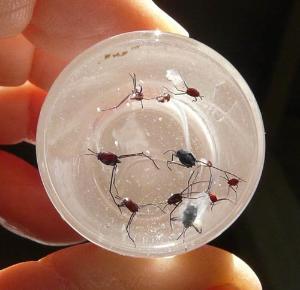Published in the Ocean Watch column, Honolulu Star-Advertiser © Susan Scott
October 11, 2010

“I’ve got presents for you.”
That’s always good news in an e-mail, and this time it was exciting news, too. My friend had recently returned from a Hawaii research voyage, and there was no telling what treasures he found in those offshore waters.
When we met, he handed me two 1-ounce glass specimen jars. One contained in preservative 10 sea skaters, marine insects I wrote about here in March. The male bodies were about the size of this letter o, females less than a quarter-inch long, and all had the bent-stick legs that allow the creatures to skate on the ocean’s surface.
Given this size, it’s hard to believe that these insects can be a major source of food for Hawaii’s petrels and other seabirds, but they are. That the birds can find such minuscule animals at sea is a wonder of nature.
The second jar contained four fish, three about three-quarters of an inch long, and one 2 inches long, also preserved.

“I don’t know what these are,” I said, squinting at the fish.
“Yes you do,” my friend said. He held the bottle up to the sun, and I saw the light. Literally. Rows of dots along the sides and heads of the fish sparkled in the afternoon sun. These were the light-producing organs, called photophores, of another marine marvel, this one of the deep sea: lantern fish.
The 240 or so species of lantern fish are found in all oceans of the world. Generally the fish live between 650 to 3,000 feet deep, but researchers have seen lantern fish at depths of 6,000 feet and also near the surface.
Lantern fish (and other marine animals) rise toward the surface each night in masses. At sea, ships’ sonar systems often bounce off the dense schools, giving the impression of a false bottom. Since most lantern fish are only 3 to 4 inches long, sonar detection attests to the fishes’ enormous numbers.
In migrating upward, lantern fish are following their food, animal plankton that also rises from the depths at night. By daybreak this mass of life has descended back to the safety of the dark depths, thus escaping light-loving predators.
This strategy only partially works, though, because the predators of lantern fish often eat them at night. Lantern fish are food for whales, penguins, tunas, salmon, sharks, squid, dolphins and more.
Spinner dolphins eat lantern fish with pizazz. Researchers working in Oahu waters in 2008 learned that spinners work in chorus lines at night to herd lantern fish (and other species). About 20 dolphins swim in a straight line until they find a concentration of lantern fish. Forming a circle around the school, the dolphins swim up and down vertically in rhythm, like “the wave” of sports fans, to herd the fish.
Gradually the dolphins tighten their circle, and then one dolphin from each side, say at 12 and 6 o’clock, moves in, eats for 15 seconds and backs out, letting the next pair, at 1 and 7 o’clock, have their turn. After each dolphin has two turns, all 20 rise to the surface, take a breath and descend again, never breaking the circle. With such choreographed hunting, the lantern fish don’t have a prayer.
Besides that, the flashlights these fish carry on their heads and bodies seem to advertise their presence. But lantern fishes’ photophores are crucial to the continuation of their kind. Each species has its own pattern, and to further help these fish find the right mate in the dark, the male and female of each species also has its own array of lights.
What kind of gifts are pickled bugs and dead fish? The best kind. For me they are true treasures.